Bedlam (1946) and Summer Storm (1944)
By Toronto Film Society on July 14, 2020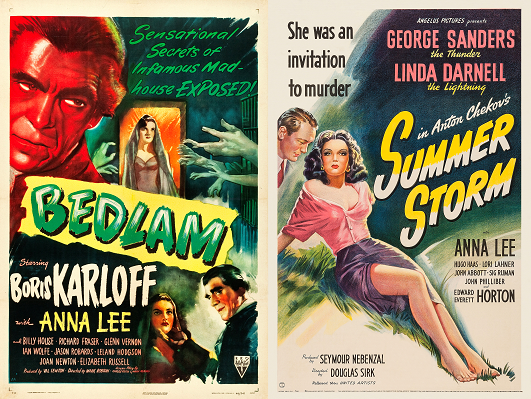
Toronto Film Society presented Bedlam (1946) on Monday, March 9, 1987 in a double bill with Summer Storm (1944) as part of the Season 39 Monday Evening Film Buffs Series “B”, Programme 8.
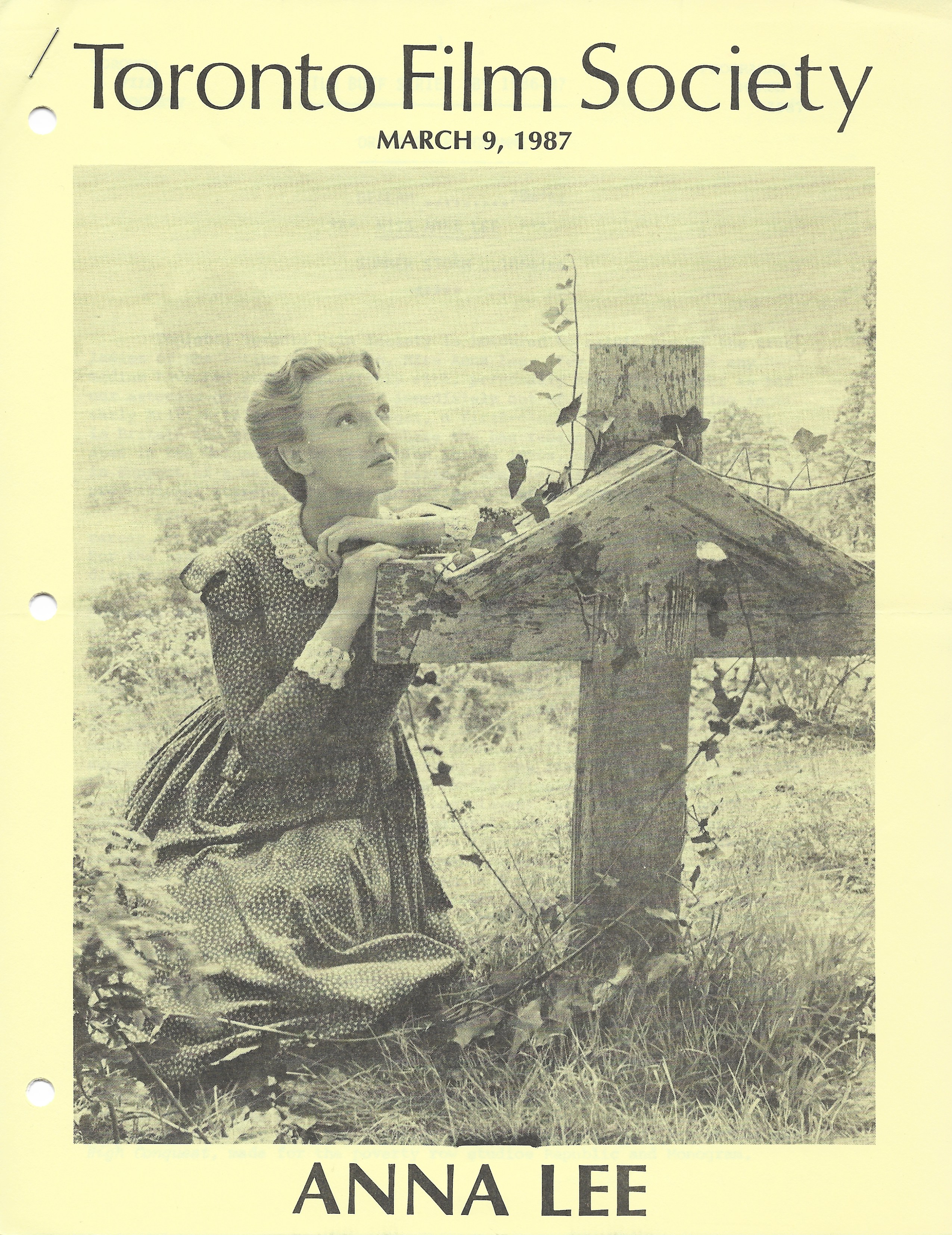
ORDER OF PROGRAMME
Bedlam ………. 78 mins
*** MISS ANNA LEE ***
Summer Storm ………. 106 mins
*****
Tonight, Toronto Film Society is honoured to salute one of the true ladies of the acting profession, Miss Anna Lee. Few performers in any medium have had such a creatively rich, personally rewarding career as has our esteemed guest. An actress immediately out of school, appearing in early British talkies as a teenager, a first-class supporting star first in Britain and then in America, where she has remained since 1939, then a star in the Golden Era of television in the 1950s, and now still a star in support of a major daytime TV series, Anna Lee is the epitome of a professional actress, the classic definition of a “trooper”.
Although Anna Lee has had a long, distinguished and multifarious career, it is her stunning work for John Ford that will always be remembered. For the last fifty years John Ford has been considered the American film director. When Orson Welles was asked which American directors most appealed to him, he answered, “…the old masters. By which I mean John Ford, John Ford and John Ford…With Ford at his best, you feel that the movie has lived and breathed in a real world…” And Anna Lee was Ford’s favourite actress, the one he employed in more films, nine (including one TV show), than any other actress (excepting Mae Marsh, D.W. Griffith’s great favourite, who made fourteen appearances, but many in bit parts and cameos). Ford never starred Miss Lee–the closest was her first, and favourite film for him, How Green Was My Valley, where she was fourth in the cast. Ford used her much the way he utilized Ward Bond in countless films–as a dependable supporting player every bit as important as the star in helping Ford attain the atmosphere and essence that made Ford’s films special. Ford drove, cajoled, terrorized and intimidated his players into delivering unique performances, whether in starring, featured, supporting or bit parts. Nobody who worked regularly with Ford–John Wayne, Henry Fonda, Ward Bond, Maureen O’Hara, Ben Johnson, Jane Darwell or Anna Lee–was ever as good in anyone else’s films as he or she was in Ford’s. In the U.S. Anna Lee worked with a trio of top directors–Fritz Lang, Douglas Sirk and Samuel Fuller, and several capable ones–Tay Garnett, Lewis Milestone, Henry King, Robert Aldrich and Robert Wise–but it is her endeavours with Ford that remain unforgettable.
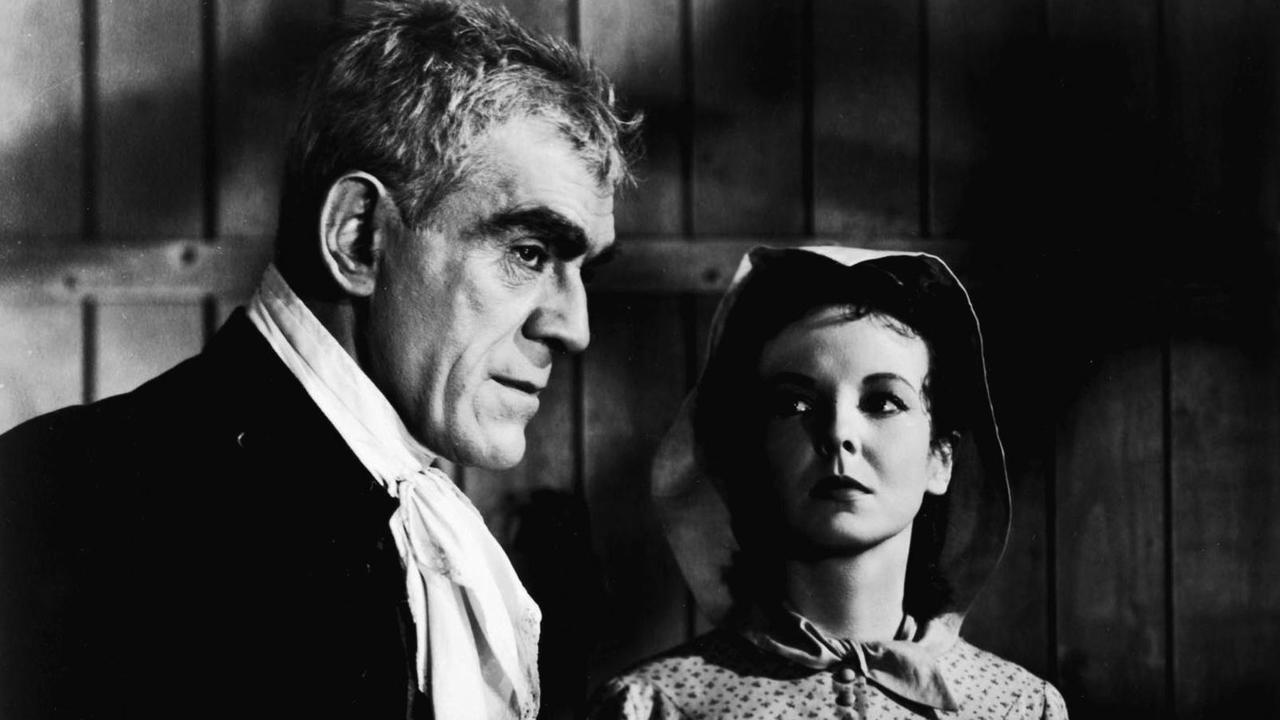
Perhaps Anna Lee’s unforced vibrancy and unerring reliability were the key elements of her acting style, and that style was too piquant to lend itself to starring parts in ordinary films. She was always good, always fascinating, but too radiant, too naturally blonde to allow her co-stars to shine. Watch her completely overwhelm John Wayne in Flying Tigers (they each appear to be in a separate movie) or circulatoriously dazzle Ronald Colman and Reginald Gardiner in My Life With Caroline. Tonight’s two films are two of her best co-starring vehicles; soon after she appeared in her only two starring films in America, G.I. War Brides and High Conquest, made for the poverty row studios Republic and Monogram.
The remainder of her career is indelibly related to John Ford. Ford understood her extraordinary strength and vitality, and only used her in those small parts. But who will ever forget Anna Lee’s Bronwyn first meeting Huw in How Green Was My Valley, or her optimism throughout the film; Mrs. Collingwood gazing one last time at her departing Captain husband in Fort Apache; widowed Mrs. Minihan deeply touched by the surprisingly tumultuous turnout at her husband’s wake in The Last Hurrah; Mrs. Gideon constantly nagging her chief detective husband about getting the salmon in Gideon’s Day; Mrs. Buford pleading with her young boy not to go off to war to die in The Horse Soldiers; snide Mrs. Malaprop’s racist gesturing in Two Rode Together; stagecoach passenger pleading with bandit Lee Marvin to not take her family jewelry in The Man Who Shot Liberty Valance?
*****
Anna Lee was born Joan Boniface Winnifrith on January 2, 1913, in Kent, England, where her father was the Rector of Ightham. In 1930, at the age of seventeen, she enrolled in the noted Central School of Speech Training and Dramatic ARt at the Royal Albert Hall in London. The school was founded by Elsie Fogerty, a dynamic elocution and speech teacher, in 1906 and directed by her until her death in 1941. Laurence Olivier entered the same school in 1924, while Ralph Richardson and John Gielgud were also involved with the school.
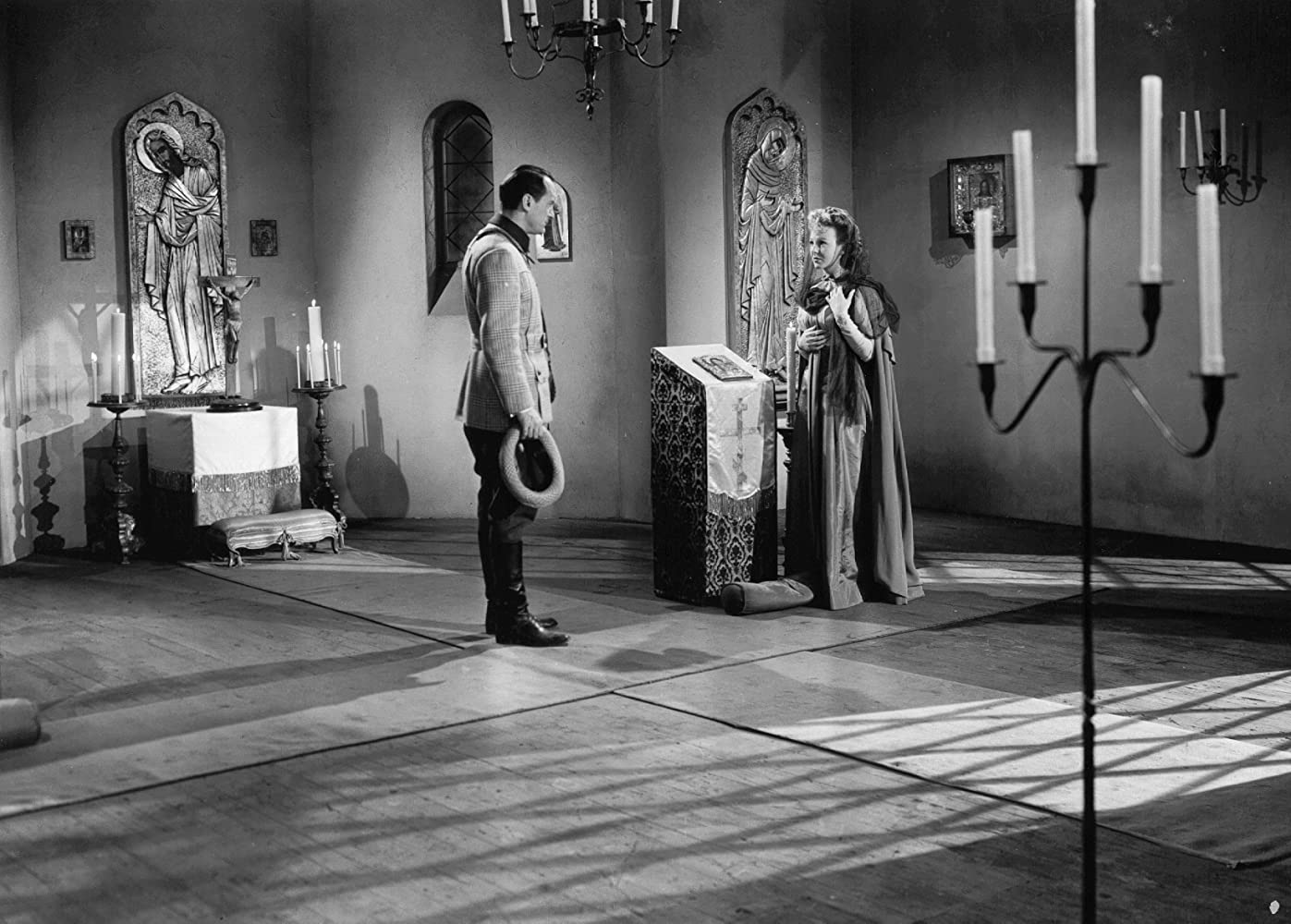
After graduation from Central School, Miss Lee spent a year with the London Repertory Theatre and then toured in such plays as “The Constant Nymph” and “Jane Eyre”. Her first film, released in February of 1932, when she had just turned nineteen, was the minor melodrama, Ebb Tide. Miss Lee was eighth on the cast list; a few notches above her was Merle Oberon in one of her earliest films. Her next film, a large scale musical co-directed by Herbert Wilcox and Jack Buchanan, and starring Mr Buchanan, set the pattern for the next few years–musicals, comedies and romances. Her first cast credit was on her seventh film, Mannequin, as Babette. The next year saw her first lead, in Faces; and she was billed on top in only two more films in her career, two poverty row films made a decade later. Meanwhile, she was fashioning a career in British cinema as “Britain’s Glamour Girl” in key films such as Tim Whelan’s delightful comedy The Camels Are Coming, Maurice Elvey’s Ruritanian musical Heat Wave, and Berthold Viertel’s imaginative fantasy The Passing of the Third Floor Back. One of Anna Lee’s most important films was 1936’s The Man Who Changed His Mind, also known as The Man Who Lived Again. It starred Boris Karloff as an evil scientist with Miss Lee ably supporting him much as she would in tonight’s first feature, Bedlam, filmed ten years later in America. The Man Who Changed His Mind was also noteworthy as Anna Lee’s first work with the director Robert Stevenson, her husband-to-be. Miss Lee and Stevenson made a total of five films together, with the next, King Solomon’s Mines, being the best, a high calibre adventure epic co-starring the immortal Paul Robeson, and much more invigorating than the later more famous Technicolor remake with Stewart Granger and Deborah Kerr. The Four Just Men was one of Britain’s most famous pre-war movies, and led to two final comedy-romances directed by Stevenson, Young Man’s Fancy, as Ada, the human cannonball, and Return to Yesterday, with Clive Brook, her twenty-second and final British film till her belated return with her favourite director (but not favourite film), John Ford, for Gideon’s Day (1958).
Anna Lee came to the United States in 1939 with her husband. Robert Stevenson was put under contract by David O. Selznick for ten years, but never worked for him, and gradually evolved into Disney’s best director. Miss Lee’s first American release was Seven Sinners in 1940. The following year saw My Life With Caroline and How Green Was My Valley released, and her career was set. A few war dramas, Flying Tigers, The Commandos Strike at Dawn, with Paul Mni and Lillian Gish, and filmed in Canada, and Hangmen Also Die, with Brian Donlevy, co-written by Bertolt Brecht, and brilliantly directed by Fritz Lang, and small roles in two onmibus films, Forever and a Day and Flesh and Fantasy led directly to tonight’s double bill.
During World War II, Anna Lee volunteered for overseas duty with the U.S.O. and entertained Allied troops in North, West and East Africa, Iran, Iraq and Sicily with Jack Benny and Adolphe Menjou. Unders special orders from General George Patton, who dubbed her M.B.–Morale Builder–and made her an honorary private in the Sixth Army, she spent several months visiting Field Hospitals in Sicily and North Africa.
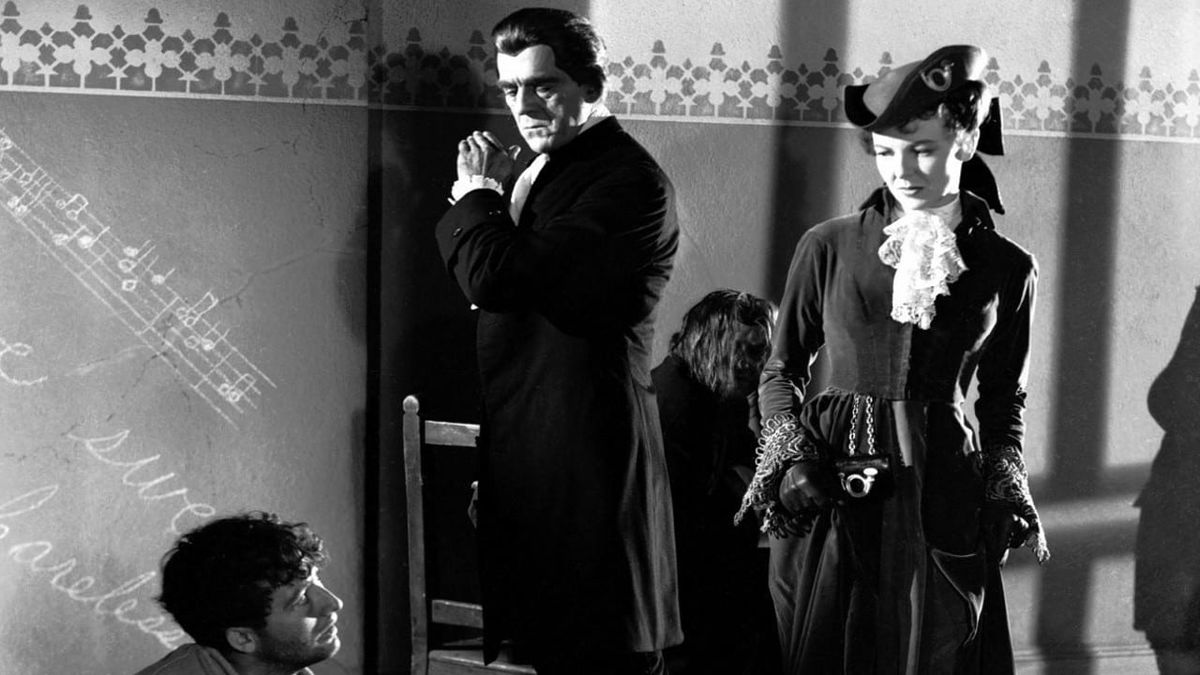
Her last two co-starring films, The Best Man Wins and Prison Warden, made 1948-49, were followed by a gap in feature films precipitated by Hollywood mixing her up with another actress, Ann Lee, who was blacklisted. Anna Lee was similarly thrown out of work, and for a while had to sign a disclaimer that she was not Ann Lee in order to obtain any work.
Affected by the blacklist, perhaps disenchanted with her career in Hollywood, and most probably to raise her family of five children, Anna Lee moved to New York in 1950 to appear in the new medium of “live” television, and to resume her theatrical career, doing two plays for The Theatre Guild. She was “anchor-man” for three years on a panel show called “It’s News To Me” with John Daly, Quentin Reynolds and Bennet Cerf. She also played ‘Mother’ in the ABC sitcom, “A Date With Judy”, and appeared in many ‘live’ television shows.
Ford’s three films, Gideon’s Day, The Last Hurrah and The Horse Soldiers, led to another flurry of supporting performances, but with progressively smaller parts, until she was listed 24th and 26th in The Unsinkable Molly Brown and Star respectively. Miss Lee has guest starred in many television series, among them “Maverick”, “Dr Kildare”, “The Loretta Young Show”, “The FBI Story”, “Perry Mason”, “Family Affair”, “Baretta”, “Mission Impossible”, “Gunsmoke”, and, more recently, “Eleanor and Franklin”, “The Night Rider”. In 1978, Anna Lee began appearing in the number one Daytime television series, “General Hospital”, in a part which she enjoys enormously, as Lila Quartermaine.
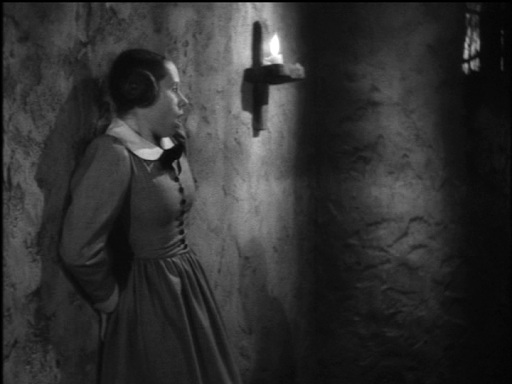
Anna Lee is the widow of Robert Nathan, the well-known novelist and poet, author of over forty novels, including Portrait of Jennie, The Bishop’s Wife and One More Spring. She has five children and four grandchildren. Her hobbies include gardening, embroidery, music and reading. She collects antiques and British Commonwealth coins. Her favourite charity in The Royal Oak Foundation of California, of which she is Chairman of the Board. It is an organisation dedicated to the preservation of places of historical interest and beauty on both sides of the Atlantic. She is very proud of her Scottish heritage and is a member of the Macfarlane Clan.
In 1983 Anna Lee was awarded the M.B.E. (Member of the Most Excellent Order of the British Empire) by Queen Elizabeth.
She has also won the ‘Soapy’ Award for “Best Actress in a Mature Role”, which was presented on the Merv Griffin Show in March, 1983.
*****
ANNA LEE FILMOGRAPHY
1932 Ebb Tide – Directed by Arthur Rosson = 8th in cast
Say It With Music – Jack Raymond = 7th in cast
1933 Yes Mr Brown – Herbert Wilcox, Jack Buchanan = 7th in cast
The King’s Cup – Herbert Wilcox = 10th in cast
Mayfair Girl – George King = 10th in cast
The Bermondsey Kid – Ralph Dawson = 11th in cast
Mannequin – George A. Cooper – 9th in cast, as Babette
Chelsea Life – Sidney Morgan = 3rd in cast
1934 Faces – Sidney Morgan = 1st in cast
Lucky Loser – Reginald Denham = 3rd in cast
Rolling in Money – Al Parker = 7th in cast, as Lady Eggleby
The Camels Are Coming – Tim Whelan = 2nd in cast
1935 Heat Wave – Maurice Elvey = 4th in cast
The Passing of the Third Floor Back – Berthold Viertel = 2nd in cast
First a Girl – Victor Saville = 4th in cast, with Jessie Matthews
1936 The Man Who Changed His Mind – Robert Stevenson = 2nd in cast
1937 O.H.M.S. (You’re In the Army Now) – Raoul Wash = 3rd in cast
King Solomon’s Mines – Robert Stevenson = 5th in cast
Non Stop New York – Robert Stevenson = 2nd in cast
1939 The Four Just Men – Walter Forde = 5th in cast
Young Man’s Fancy – Robert Stevenson = 2nd in cast
1940 Return to Yesterday – Robert Stevenson = 2nd in cast
Seven Sinners – Tay Garnett = 8th in cast
1941 My Life With Caroline – Lewis Milestone = 2nd in cast
How Green Was My Valley – John Ford = 4th in cast
1942 Flying Tigers – David Miller = 3rd in cast
1943 The Commandos Strike at Dawn – John Farrow = 2nd in cast
Hangmen Also Die – Fritz Lang = 2nd in cast
Forever and a Day – Rene Clair = 71st in cast (bit)
Flesh and Fantasy – Julien Duvivier = 8th in cast
1944 Summer Storm – Douglas Sirk = 4th in cast
1946 Bedlam – Mark Robson = 2nd in cast
G.I. War Brides – George Blair = 1st in cast
1947 The Ghost and Mrs Muir – Joseph Mankiewicz = 6th in cast
High Conquest – Irving Allen = 1st in cast
1948 Fort Apache – John Ford = 9th in cast
The Best Man Wins – John Sturges = 2nd in cast
1949 Prison Warden – Seymour Friedman = 2nd in cast
1958 Gideon’s Day* – John Ford = 13th in cast
The Last Hurrah – John Ford = 15th in cast
1959 The Horse Soldiers – John Ford = 6th in cast
The Crimson Kimono – Samuel Fuller = 4th in cast
1960 The Big Night – Sidney Salkow = 6th in cast
Jet Over the Atlantic – Byron Haskin = 6th in cast
1961 Two Rode Together – John Ford = 16th in cast
1962 The Man Who Shot Liberty Valance – John Ford = 22nd in cast
Jack the Giant Killer – Nathan Jurow = 9th in cast
Whatever Happened to Baby Jane? – Robert Aldrich = 6th in cast
1964 For Those Who Think Young – Leslie Martinson = 17th in cast
The Unsinkable Molly Brown – Charles Walters = 24th in cast
1965 The Sound of Music – Robert Wise = 13th in cast
1966 Seven Women – John Ford = 7th in cast
Picture Mommy Dead – Bert Gordon = 8th in cast
1967 In Like Flint – Gordon Douglas = 5th in cast
1968 Star – Robert Wise = 26th in cast
*Gideon’s Day only British film after Return to Yesterday
Notes and Filmography by Jaan Salk
*****
Bedlam (1946)
Production Company: RKO-Radio Pictures. Producer: Val Lewton. Director: Mark Robson. Screenplay: Carols Keith and Mark Robson, suggested by the William Hogarth painting. Photography: Nicholas Musuraca. Editor: Lyle Boyer. Art Direction: Albert S. D’Agostino, Walter E. Keller. Set Decoration: Darrell Silvera. Special Effects: Vernon L. Walker. Music: Rob Webb. Musical Direction: C. Bakaleinikoff. Costumes: Ed Stevenson.
Cast: Boris Karloff (Master Sims), Anna Lee (Nell Bowen), Billy House (Lord Mortimer), Richard Fraser (Hannay), Glenn Vernon (The Gilded Boy), Ian Wolfe (Sidney Long), Jason Robards Sr. (Oliver Todd), Leland Hodgson (John Wilkes), Joan Newton (Dorothea the Dove), Elizabeth Russell (Mistress Sims), Victor Holbrook (Tom the Tiger), Robert Clarke (Dan the Dog), Ellen Corby (Queen of the Artichokes), etc.
The setting for Bedlam is eighteenth-century England, and St. Mary’s of Bethlehem, the rather bizarre name of the insane asylum which was known infamously to Londoners of the period as “Bedlam”. It was a building of filth, unbelievable squalor and cruelty. It inspired the famed painter-satirist William Hogarth to create what is generally regarded as one of his most biting canvases. This was the background from which the motion picture was produced.
Reviews at the time placed the film several cuts above the so-called average horror film. The story concerns an actress (Anna Lee) who deserts her nobleman patron, because he is blind to the sadistic treatment of the inmates of the institution. Fearful that she will expose the workings of the asylum to John Wilkes, the great English liberal of the time, the chief warden has her cast into “bedlam” on a trumped-up charge. From here, Nell Bowen fights a double fight…for her own life, and for the cleanup of the institution. The New York Times, in its review, described the performance of Anna Lee as “fine”, bringing a spark and compassion to the role of the crusading young girl, and even putting life into the eighteenth-century rhetoric that frequently handicaps the script. The same review noted briefly, but succinctly that Boris Karloff, as the sadistic chief warden, is completely at home, and is his usual sinister self…
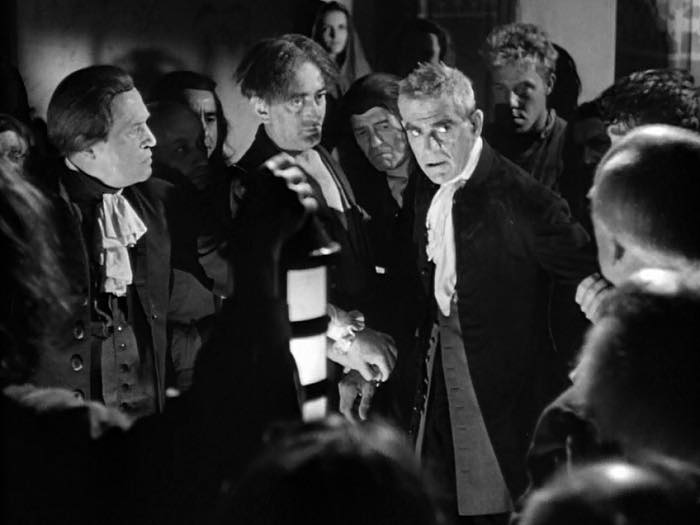
Boris Karloff was born William Henry Pratt in November of 1887 in the London suburb of Dulwich. He was the youngest of the eight children of a civil servant in the British foreign service. In 1909, he emigrated to Canada, and found work as a farm hand in the areas just south of Hamilton. He was attracted to the stage and moved from one touring company to another. He moved across Canada and the United States for the next ten years. In 1916, he made his movie debut in a Pavlova film, as an extra, but the career was still a long way from flourishing. He returned to Hollywood, took bit parts, and worked as a truck driver to eek out a living. Although he appeared in about 40 silent films, mostly as a villain, he atracted little attention. With the transition to sound, his stage trained voice became an asset, and he scored his first success in The Criminal Code (1930), which was a role he had portrayed on stage. But the anonymity ended the following year, when James Whale cast Karloff in the role of the Monster in Frankenstein, a role that had been turned down by Bela Lugosi. Even under the heavy makeup, Karloff’s performance in that film shone through. He and Lugosi often teamed during the hey-day of the Universal horror films in the 1930’s.
Although he played other roles, including the well-rated religious fanatic in John Ford’s The Lost Patrol in 1934, he was identified int he public mind exclusively as the tormented, humanely vulnerable monster, or a deranged scientist. In reality, however, he was a mild-mannered amiable gentleman who worked closely with charities for needy children. He narrated a Mother Goose children’s story record, and played the kindly Colonel March of Scotland Yard on television. Karloff continued to return to the stage through his career, scoring a huge success in 1941 as Johnathon Brewster in the Broadway production of Arsenic and Old Lace, and again in 1950 when he played Captain Hook in Peter Pan. One of his last screen roles provided one of his best performances, when he virtually played himself as an aging star of horror movies in Peter Bogdanovich’s Targets in 1968. He died in February of 1969.
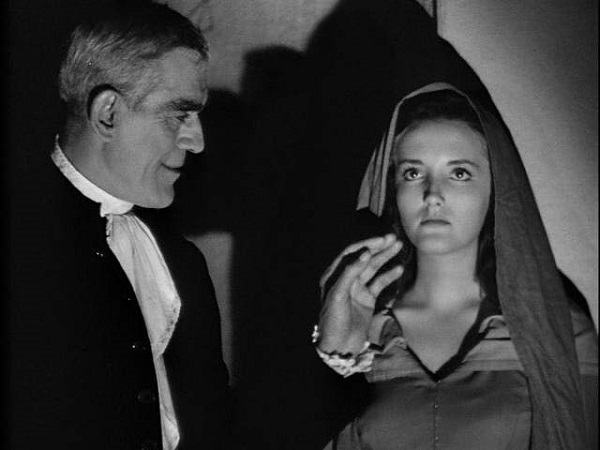
Director Mark Robson was born in Montreal in 1913, and was educated in political sciences and economics at the University of California in Los Angeles, as well as law at Pacific Coast University. In 1932 he began working as a prop boy at Fox. Three years later he joined RKO, working as a sound cutter and editor. In 1941 he collaborated on the editing of Citizen Kane with Robert Wise, and was co-editor of The Magnificent Ambersons. In 1942, after working as editor of Cat People for Val Lewton, he had the door opened to work as a director on Lewton-produced horror films, including Bedlam. His first major picture as a director was Champion for Stanley Kramer in 1949. Robson died in 1978.
During the interval between films, there will be a discussion with Miss ANNA LEE, star of both of tonight’s films.
Summer Storm (1944)
Production Company: Angelus Pictures, released by United Artists. Producer: Seymour Nebenzal. Director: Douglas Sirk. Screenplay: Rowland Leigh and Douglas Sirk, from the adaptation by Douglas Sirk and Michael O’Hara (aka Douglas Sirk) of “The Shooting Party” by Anton Chekhov, Additional Dialogue by Robert Thoeren. Photography: Archie Stout (credited, but mostly shot by Eugen Shuftan). Editor: Gregg Tallas. Art Direction: Rudi Feld. Music: Karl Hajos. Technical Consultant: Eugen Shuftan. Costumes: Max Pretzfelder.
Cast: George Sanders (Fedor Petroff), Linda Darnell (Olga), Anna Lee (Nadina), Edward Everett Horton (Count Volsky), Hugo Haas (Urbenin), Lori Lahner (Clara), John Philliber (Polycarp), Sig Ruman (Kuzma), André Charlot (Mr Kalenin), Mary Servoss (Mrs Kalenin), John Abbott (Lunin), Robert Greig (Gregory), Paul Hurst (Orloff), Charles Trowbridge (Doctor), Sarah Padden, Mike Mazurki, etc.
Summer Storm is a film rarely seen, a film little-known because of the distribution difficulties which have made it all but invisible for viewing since its release in 1944. However, reviews of the film have all been positive, and the writer was lucky enough to obtain a print some years ago.
The film is based on Chekhov’s “The Shooting Party” and is set in Tsarist Russia, when fortunes of the elite were being taken away, sprawling estates were being seized, and the rich…became the poor!! The New York Times, in its review, praises the “expert characterizations, biting dialogue and generally smooth direction”. The Times Review continues: “Although the problems and foibles of the Russian aristocracy of 1912 may be vague today, Summer Storm has managed to revive the scene, and the decaying mores of pre-revolutionary Russia.”
The film is set in the Kharkov district, where Olga, the illiterate, beautiful, scheming daughter of a peasant woodcutter on the estate of Count Volsky, sets the storm brewing. She eyes the goals of wealth and a fine marriage, and casts her gaze first on Fedor Petroff, the provincial judge, and ultimately on the Count himself. She is married to the Count’s overseer, but launches into an affair with the Judge. And, from this point, tragedy stalks, and overtakes the characters.
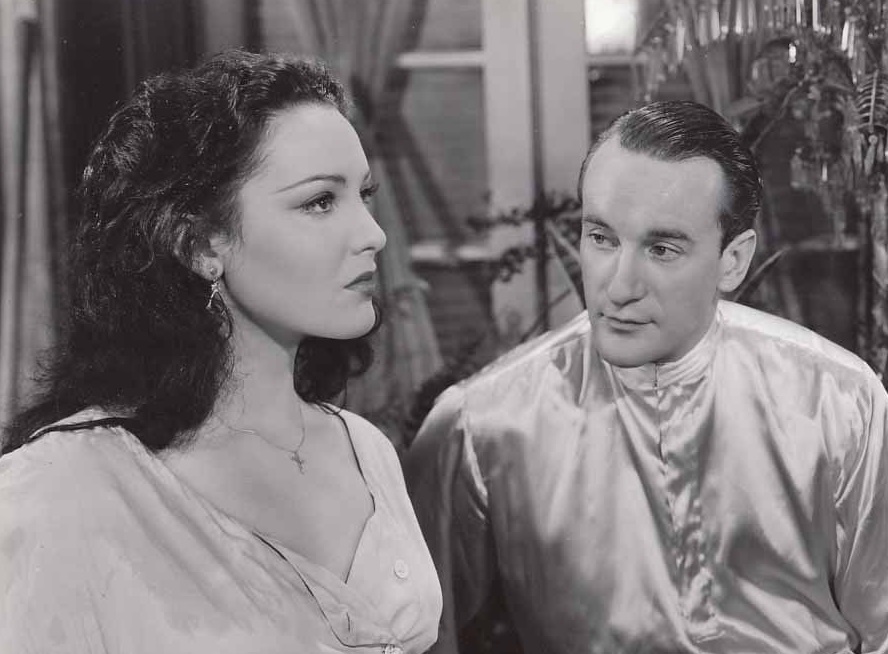
George Sanders, as Judge Petroff, gives an excellent portrayal. Sanders was born in St. Petersburg, Russia, of English parents, in 1906, and attended a Russian grade school. He entered show business as a chorus boy, and appeared on radio. His film debut came in 1936 in Find the Lady. He generally played villains, but was successful in two “private eye” series–as The Saint, and The Falcon. He received the Oscar as Best Supporting Actor in 1950, for his performance in All About Eve. Sanders died at his own hand in 1973.
Reviewer Phillip Kemp says Sanders could “outsneer Basil Rathbone and outpurr Vincent Price. He deployed irresistible charm with an edge of menace, buffered by a disconcerting sense of languid indifference”.
Sanders frequently proclaimed his own laziness, saying his desire as a boy “was to retire”. He also had contempt for the whole business of acting. During the war years he was cast time after time as the most despicable of Nazis. Sanders once commented, “I was beastly, but I was never coarse. I was a high-class sort of heel”. He thrived on good material, and was most at home with the word-oriented director Joseph Mankiewicz in All About Eve, where his performance as the addler-tongued drama critic Addison De Witt won him the Oscar.
Toward the end of his career, the overall quality of his material was little more than abysmal. One of his last assignments was in Walt Disney’s Jungle Book, where he was impeccably cast as the voice of Shere Khan, the soft-spoken, razor-clawed tiger. His suicide note was wholly in character–“Dear World, I am leaving, because I am bored”.
Linda Darnell was born in Texas in 1923, was a child dancer, then worked as a model. She was under contract to 20th Century Fox from 1939-1951, and began her film career in 1939 with Hotel for Women. She is remembered for several appearances with Tyrone Power, starting with Day-Time Wife in 1939. She died tragically in a house fire in 1965. Miss Darnell gives in Summer Storm a surprisingly adept performance as the beautiful and designing Olga. She was never a “super star”, but was a very popular attraction for the studio. Her career began to decline sharply in the early 1950s, after the termination of her Fox contract, after which she appeared mainly in minor productions. She was seen in only one film after 1957, but turned up occasionally on the stage and in television dramas.
Her tragic death in 1965 came in a fire as she visited her former secretary in a Chicago suburb. Ironically, the house caught fire as they watched a television screening of one of her movies, Star Dust. The first of her three husbands was cameraman Perverall J. Marley, to whom she was married from 1943 to 1952. Some of Linda Darnell’s other notable films include Centinnial Summer (1946), My Darling Clementine (1946), Forever Amber (1947), A Letter to Three Wives (1949), and Slattery’s Hurricane (1949).
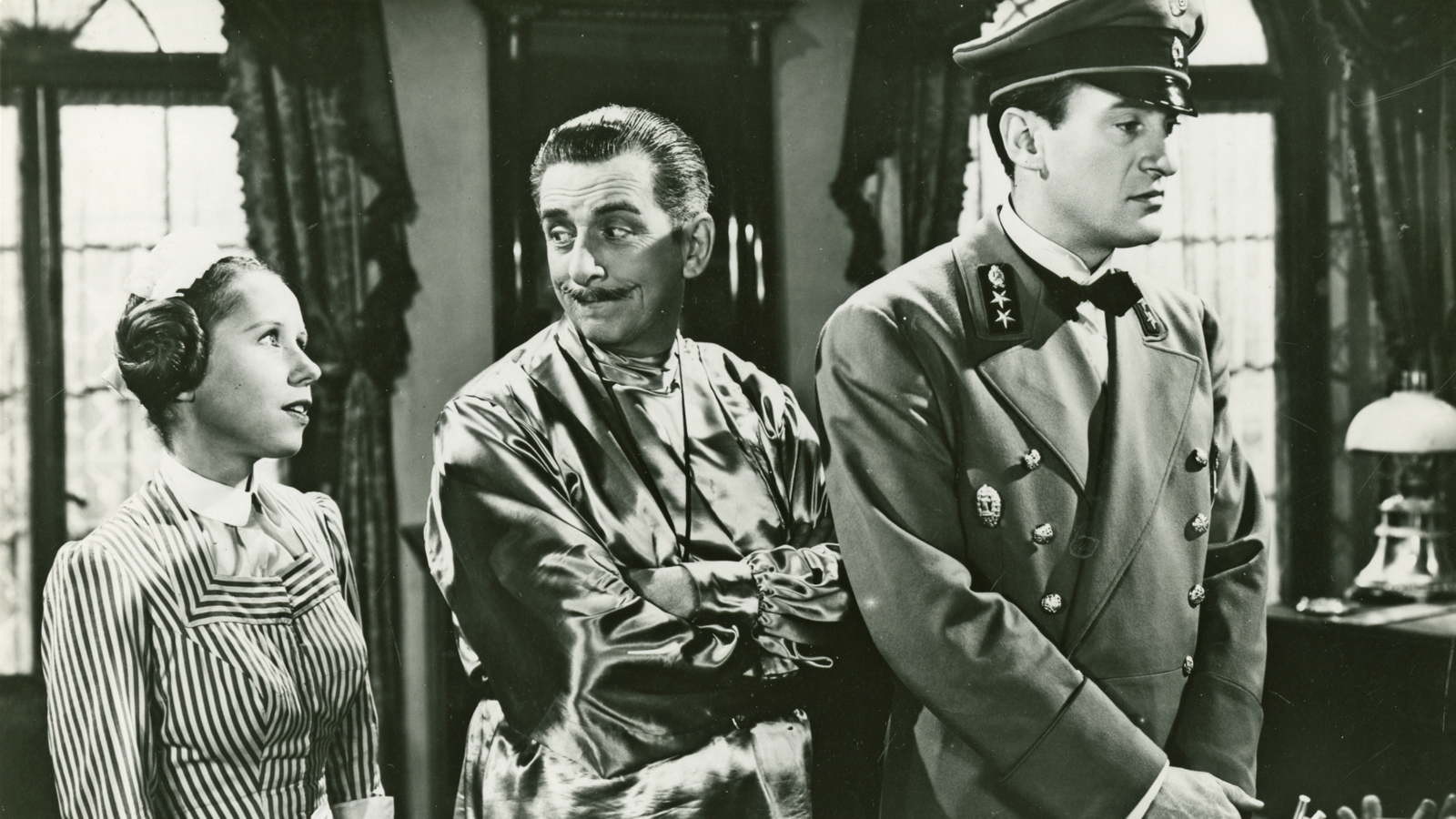
Edward Everett Horton was born in Brooklyn in 1886, performed in college productions, and made his screen debut in the 1920s. In the some 150 films in which he appeared, Horton was, virtually without fail, a delightful comic lead or character, pictured typically as a jittery, befuddled fussbudget with inimitable “oh dear!” doomsday utterances. He is fondly remembered as Fred Astaire’s sidekick in several musicals of the 30’s, and in the sophisticated Lubitsch comedies. And, not unlike the characters he often played, he never married. In later years, he was a familiar figure on the stage circuit, playing various Toronto engagements, and also a visitor almost every year to the late, lamented Prudhomme’s Garden Centre Theatre, near St. Catharines.
Some of his credits include the title role in Ruggles of Red Gap (1923), The Whole Town’s Talking (1926), Kiss Me Again (1931), The Front Page, Alice In Wonderland (as the Mad Hatter, 1933), The Gay Divorcee (1934), Top Hat (1935), Lost Horizon (1937), Shall We Dance, I Married An Angel (1942), Arsenic and Old Lace (1944), Pocketful of Miracles (1961), t’s a Mad, Mad, Mad, Mad, Mad World (1963), Cold Turkey (1971). On television, he was in the cast of “F Troop” in the mid 60’s. Horton died of cancer in 1970.
The Director, Douglas Sirk, was born in Hamburg in April of 1900, as Hans Detlef Sierck. He changed his name to Doulgas Sirk after emigrating to the United States. His early education was in law, philosophy, and art history in Copenhagen and Hamburg. His connection with the stage, as a successful producer and director began in the ’20s. He was a Leftist politically, an came under increasing pressure from the authorities after the Nazi rise to power. In 1934, he decided to switch to films, an industry that because of its international market was under less rigorous control by the Nazi regime than was the the theatre.
He started with the direction of shorts, then moved to features in the mid ’30’s, quickly gaining a reputation for the visual excellence of his productions. In 1937 he left Germany and arrived as a virtual unknown in Hollywood, where he once again was forced to build his reputation from scratch. He started with a range of low budget productions, but managed to turn many of them into enjoyable “little pictures” as our patron and frequent guest Bill Everson would put it. Sirk was put under contract by Warner Brothers to prepare a new version of “To New Shores”, a project which never came to fruition. In 1942, he was under a writing contract with Columbia Pictures, and working with a group of German emigres, directed Hitler’s Madman and Summer Storm as independent productions. In 1950, he began directing for Universal. For health reasons he retired from filmmaking in 1959, and returned to Europe. He remained active in German theatre. Douglas Sirk died late in 1986.
Some of Sirk’s other directorial projects included Sleep My Love (1948), Thunder on the Hill (1952), Magnificent Obsession (1954), All That Heaven Allows (1955), Written on the Wind (1956), Battle Hymn (1958), Interlude, The Tarnished Angels, Imitation of Life (1959).
Notes by Bill Sturrup
Toronto Film Society would sincerely like to thank Ted Gilling and Lilana Novakovich for their efforts in making the visit by Anna Lee possible.
And special thanks to Sutton Place Hotel for considerations regarding accommodation for Anna Lee during her visit to Toronto.
The film So Long At The Fair, will be included in the Film Buff programme for next season.
You may also like...
One response to “Bedlam (1946) and Summer Storm (1944)”
-
News

Frances Blau
Toronto Film Society | February 27, 2024On Monday, February 26th, 2024, Toronto Film Society lost longtime friend, supporter, and board member Frances Blau. Known for her sense of humour, her love of film, her generosity,...
-
Special Events

Arsenic and Old Lace (1944) at the Paradise Theatre
Toronto Film Society | April 21, 2024Toronto Film Society presents Arsenic and Old Lace (1944) at the Paradise Theatre on Sunday, May 5, 2024 at 2:30 p.m. Screwball comedy meets the macabre in one of...
Programming

Virtual Saturday Night at the Movies
Toronto Film Society | April 11, 2024Toronto Film Society is back in the theatre! However, we’re still pleased to continue to bring you films straight to your home! Beginning Season 73 until now we have...
4-
 Toronto Film Society | April 21, 2024
Toronto Film Society | April 21, 2024
-
 Toronto Film Society | November 6, 2022
Toronto Film Society | November 6, 2022
-
 Toronto Film Society | August 1, 2023
Toronto Film Society | August 1, 2023
Donate to Toronto Film Society – We’re now a Registered Charity!
-
Copyright © 2017 Toronto Film Society.

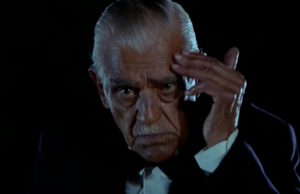
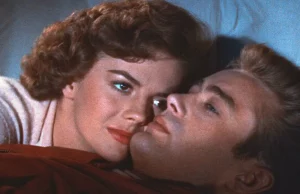
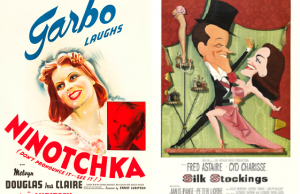
[…] early days of the Pandemic was Val Lewton’s Bedlam (1946) directed by Mark Robson. Adding the notes to the TFS website, it reminded me that I had attended the screening of this film back in March […]